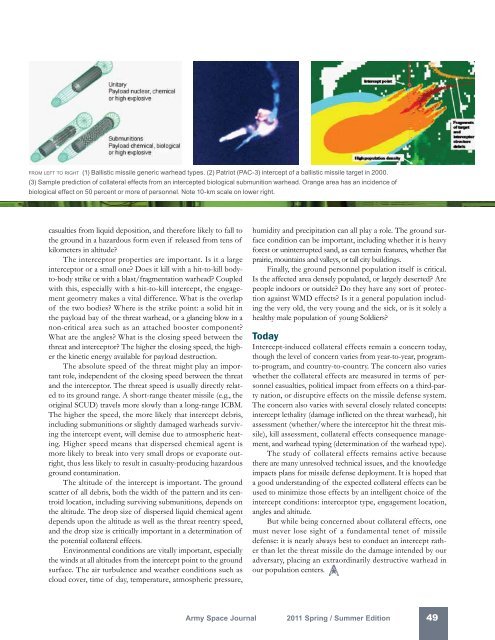Spring 2011 - Space and Missile Defense Command - U.S. Army
Spring 2011 - Space and Missile Defense Command - U.S. Army
Spring 2011 - Space and Missile Defense Command - U.S. Army
Create successful ePaper yourself
Turn your PDF publications into a flip-book with our unique Google optimized e-Paper software.
from left to right (1) Ballistic missile generic warhead types. (2) Patriot (PAC-3) intercept of a ballistic missile target in 2000.<br />
(3) Sample prediction of collateral effects from an intercepted biological submunition warhead. Orange area has an incidence of<br />
biological effect on 50 percent or more of personnel. Note 10-km scale on lower right.<br />
casualties from liquid deposition, <strong>and</strong> therefore likely to fall to<br />
the ground in a hazardous form even if released from tens of<br />
kilometers in altitude?<br />
The interceptor properties are important. Is it a large<br />
interceptor or a small one? Does it kill with a hit-to-kill bodyto-body<br />
strike or with a blast/fragmentation warhead? Coupled<br />
with this, especially with a hit-to-kill intercept, the engagement<br />
geometry makes a vital difference. What is the overlap<br />
of the two bodies? Where is the strike point: a solid hit in<br />
the payload bay of the threat warhead, or a glancing blow in a<br />
non-critical area such as an attached booster component?<br />
What are the angles? What is the closing speed between the<br />
threat <strong>and</strong> interceptor? The higher the closing speed, the higher<br />
the kinetic energy available for payload destruction.<br />
The absolute speed of the threat might play an important<br />
role, independent of the closing speed between the threat<br />
<strong>and</strong> the interceptor. The threat speed is usually directly related<br />
to its ground range. A short-range theater missile (e.g., the<br />
original SCUD) travels more slowly than a long-range ICBM.<br />
The higher the speed, the more likely that intercept debris,<br />
including submunitions or slightly damaged warheads surviving<br />
the intercept event, will demise due to atmospheric heating.<br />
Higher speed means that dispersed chemical agent is<br />
more likely to break into very small drops or evaporate outright,<br />
thus less likely to result in casualty-producing hazardous<br />
ground contamination.<br />
The altitude of the intercept is important. The ground<br />
scatter of all debris, both the width of the pattern <strong>and</strong> its centroid<br />
location, including surviving submunitions, depends on<br />
the altitude. The drop size of dispersed liquid chemical agent<br />
depends upon the altitude as well as the threat reentry speed,<br />
<strong>and</strong> the drop size is critically important in a determination of<br />
the potential collateral effects.<br />
Environmental conditions are vitally important, especially<br />
the winds at all altitudes from the intercept point to the ground<br />
surface. The air turbulence <strong>and</strong> weather conditions such as<br />
cloud cover, time of day, temperature, atmospheric pressure,<br />
humidity <strong>and</strong> precipitation can all play a role. The ground surface<br />
condition can be important, including whether it is heavy<br />
forest or uninterrupted s<strong>and</strong>, as can terrain features, whether flat<br />
prairie, mountains <strong>and</strong> valleys, or tall city buildings.<br />
Finally, the ground personnel population itself is critical.<br />
Is the affected area densely populated, or largely deserted? Are<br />
people indoors or outside? Do they have any sort of protection<br />
against WMD effects? Is it a general population including<br />
the very old, the very young <strong>and</strong> the sick, or is it solely a<br />
healthy male population of young Soldiers?<br />
Today<br />
Intercept-induced collateral effects remain a concern today,<br />
though the level of concern varies from year-to-year, programto-program,<br />
<strong>and</strong> country-to-country. The concern also varies<br />
whether the collateral effects are measured in terms of personnel<br />
casualties, political impact from effects on a third-party<br />
nation, or disruptive effects on the missile defense system.<br />
The concern also varies with several closely related concepts:<br />
intercept lethality (damage inflicted on the threat warhead), hit<br />
assessment (whether/where the interceptor hit the threat missile),<br />
kill assessment, collateral effects consequence management,<br />
<strong>and</strong> warhead typing (determination of the warhead type).<br />
The study of collateral effects remains active because<br />
there are many unresolved technical issues, <strong>and</strong> the knowledge<br />
impacts plans for missile defense deployment. It is hoped that<br />
a good underst<strong>and</strong>ing of the expected collateral effects can be<br />
used to minimize those effects by an intelligent choice of the<br />
intercept conditions: interceptor type, engagement location,<br />
angles <strong>and</strong> altitude.<br />
But while being concerned about collateral effects, one<br />
must never lose sight of a fundamental tenet of missile<br />
defense: it is nearly always best to conduct an intercept rather<br />
than let the threat missile do the damage intended by our<br />
adversary, placing an extraordinarily destructive warhead in<br />
our population centers.<br />
<strong>Army</strong> <strong>Space</strong> Journal <strong>2011</strong> <strong>Spring</strong> / Summer Edition 49
















